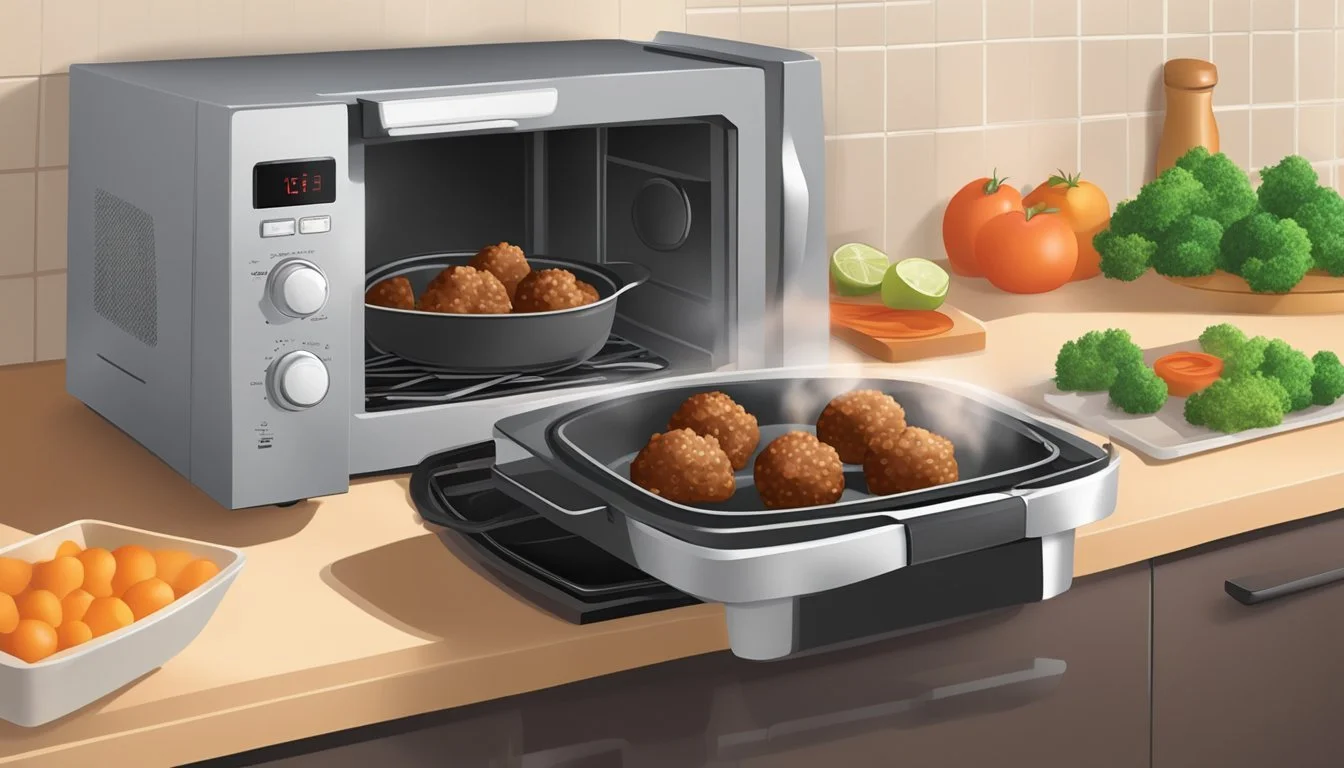How to Reheat Gluten-Free Meatballs for Perfect Taste and Texture
Reheating gluten-free meatballs can be a straightforward process, but it's crucial to know the best methods to maintain their texture and flavor. Whether using an oven, stovetop, or microwave, each technique offers specific benefits that ensure your meatballs remain delicious and tender.
The most effective way to reheat gluten-free meatballs is in the oven, as this method helps keep them moist and evenly heated. Preheat your oven to 350°F, place the meatballs on a baking sheet, and cover them with aluminum foil to prevent drying out. Heat them for about 15-20 minutes, or until they reach your desired warmth.
For those in a hurry, the microwave can be a quick solution. Place the meatballs in a microwave-safe dish, cover them with a damp paper towel, and heat on medium power in 30-second intervals until thoroughly warmed. This method is efficient but requires careful monitoring to avoid overheating.
Understanding Gluten-Free Cooking
Gluten-free cooking involves careful selection of ingredients to ensure that no gluten, a protein found in wheat, barley, and rye, is present. This type of cooking is essential for individuals with celiac disease or gluten intolerance.
Essentials of Gluten-Free Ingredients
Gluten-free cooking relies on substituting traditional wheat-based products with alternatives. Ingredients commonly used include rice flour, almond flour, and gluten-free oats.
Cross-contamination is a crucial consideration. Even trace amounts of gluten can cause health issues for individuals with celiac disease. It is essential to use separate utensils and cooking spaces to prevent cross-contact with gluten-containing foods.
Binding agents such as xanthan gum or guar gum often replace gluten in baking and cooking. These agents help to maintain the texture and structural integrity of gluten-free dishes.
Dairy and eggs are often used as additional binding agents but must be checked to ensure they are free from gluten-containing additives or contamination.
Benefits of Gluten-Free Meatballs for Health
Gluten-free meatballs provide a safe and nutritious option for those with celiac disease or gluten intolerance. These meatballs reduce the risk of gastrointestinal discomfort, inflammation, and other symptoms associated with gluten ingestion.
Health benefits extend beyond those with gluten issues. Gluten-free meatballs can be lower in carbohydrates, particularly if using almond flour or other nut-based substitutes instead of traditional breadcrumbs.
Nutrient density is often higher in gluten-free meatballs. Ingredients like oats, chia seeds, or flaxseed can be added to provide additional fiber, omega-3 fatty acids, and essential vitamins.
Digestive health can improve due to the incorporation of whole, unprocessed ingredients that are easier on the stomach and intestines.
Preparation of Gluten-Free Meatballs
Creating gluten-free meatballs that are both delicious and satisfying requires attention to ingredient selection, proper combining of elements, and forming meatballs correctly. Following these steps will ensure your meatballs have the right texture and flavor.
Selecting the Right Ingredients
Choosing the right type of meat is crucial. Ground beef, ground turkey, ground pork, or ground chicken can be used, depending on your preference. Each type of meat offers a unique flavor and texture.
Opt for gluten-free breadcrumbs to maintain the meatballs' structure without compromising dietary restrictions. Ensure herbs and spices such as Italian seasoning, garlic powder, salt, and black pepper are incorporated to enhance the flavor.
For binding, use a beaten egg. If you're dairy-free, you can substitute with egg replacements like flaxseed meal mixed with water. Fresh parsley and onion can also add freshness and complexity to your meatballs' taste.
Combining Ingredients for the Perfect Blend
Start by combining your dry ingredients in a large bowl. This will typically include gluten-free breadcrumbs, your selected herbs, and spices. Mix well to ensure an even distribution of flavors.
Next, add the ground meat(s) of your choice. Whether it's beef, turkey, pork, or chicken, ensure it is well-mixed into the dry ingredients. Adding an egg (or substitute) is essential to bind everything together.
If using fresh parsley and onion, mix them finely before adding to avoid large chunks. Make sure everything is combined thoroughly but avoid over-mixing as this can make the meat tough.
Forming the Meatballs
Once your mixture is ready, it's time to form the meatballs. Take a small portion, approximately 2-3 tablespoons, and roll it into balls using your palms. Aim for uniform size for even cooking.
Heat a skillet with a small amount of olive oil to prevent sticking. Gently add the meatballs, making sure not to overcrowd the pan. Cook until browned on all sides, then transfer to a preheated oven if required to finish cooking.
These steps will help you create well-shaped meatballs that cook evenly and retain a moist, tender texture.
Cooking Methods for Gluten-Free Meatballs
There are several methods to prepare gluten-free meatballs, each offering unique benefits. Whether you prefer baking, using a skillet, or modern appliances like a slow cooker or air fryer, these techniques ensure delicious, easy-to-make meatballs.
Baking Gluten-Free Meatballs
Baking provides an even heat distribution, ensuring the meatballs are cooked thoroughly. Preheat the oven to 350°F. Line a cookie sheet with parchment paper or a silicone mat. Arrange the meatballs on the sheet, spacing them about an inch apart. Bake for around 20-25 minutes or until they reach an internal temperature of 165°F. This method minimizes oil use, creating a healthier option.
Cooking in a Skillet
A skillet builds a crunchy exterior while keeping the inside moist. Heat 3-4 tablespoons of olive oil in a heavy-bottomed, oven-safe skillet like cast iron over medium-high heat. Place the meatballs in the pan, ensuring an even layer. Sear for about 2 minutes on each side, totaling 8 minutes. This technique lends a rich, caramelized crust.
Utilizing the Slow Cooker
Slow cookers make for a tender, flavorful outcome. Add a layer of meatballs to the slow cooker. Pour your favorite sauce over them, ensuring they're fully covered. Cook on low for 6-8 hours or on high for 3-4 hours. This method is convenient for busy schedules as it requires minimal supervision. The slow, steady heat melds the flavors wonderfully.
Air Fryer Technique
Air fryers offer a quick, crispy finish without excessive oil. Preheat the air fryer to 375°F. Arrange the meatballs in the basket, making sure they don't touch. Cook for 10-12 minutes, shaking the basket halfway through to ensure even cooking. This provides a crunchy exterior similar to frying but with far less oil, making it a healthier alternative.
How to Reheat Gluten-Free Meatballs Effectively
To preserve the flavor and texture of gluten-free meatballs, choose the right reheating method. Different techniques can be tailored to suit what you have available and your moisture preference.
Oven Reheating
Preheat the oven to 350°F (175°C). Place the meatballs on a baking sheet lined with parchment paper. Cover the meatballs lightly with aluminum foil to prevent drying out. Heat them in the oven for around 15-20 minutes, checking to ensure they are heated through.
For added moisture, sprinkle a small amount of broth or water over the meatballs before covering them with foil. This method helps retain their juicy texture and revitalizes the flavors.
Microwave Tips and Tricks
Place the meatballs in a microwave-safe dish. Cover them with a damp paper towel to maintain moisture. Heat on medium power in 1-minute intervals, ensuring the meatballs are evenly heated.
To avoid overcooking, avoid using high power settings. Stir the meatballs occasionally between intervals to ensure even reheating. This is a quick method, ideal for fast meals but should be done with care to prevent them from becoming tough.
Skillet Warming
Heat a small amount of oil in a skillet over medium heat. Add the meatballs and cook, turning occasionally. This reheating approach usually takes about 10 minutes, depending on the size of the meatballs.
Cover the skillet with a lid to trap steam, which helps retain moisture inside the meatballs. This method can also create a slight crispness on the exterior, making it a favorite for some.
Keeping Moisture in Meatballs
Maintaining moisture is crucial when reheating gluten-free meatballs. Using a sauce or broth can help. For skillet or oven methods, adding a few tablespoons of broth can help keep the meatballs juicy.
Covering the meatballs during reheating, whether with foil in the oven or a damp paper towel in the microwave, prevents the loss of moisture. If reheating in a sauce, ensure the sauce is heated gently alongside the meatballs to avoid drying them out.
Freezing and Storing Gluten-Free Meatballs
Freezing and storing gluten-free meatballs properly ensures they remain fresh and tasty. Key considerations include using the right storage containers, effective defrosting techniques, and strategies to maintain maximum freshness.
Proper Freezer Storage
When freezing gluten-free meatballs, it is crucial to use freezer-safe containers or heavy-duty freezer bags. This helps prevent freezer burn and maintain flavor. Cool meatballs to room temperature before freezing to avoid condensation.
Arrange meatballs in a single layer on a baking sheet and freeze until solid, about 2 hours. This prevents them from sticking together. Once frozen, transfer them to the storage container, ensuring minimal air exposure by removing excess air from bags. Label containers with the date and contents for easy identification.
Defrosting Techniques
Defrosting gluten-free meatballs can be done using several methods. The safest way is to move them from the freezer to the refrigerator for overnight thawing. This gradual method preserves texture and flavor.
For quicker defrosting, place meatballs in a microwave-safe container and use the defrost setting on the microwave. If cooking immediately after, they can also be reheated directly from frozen in an oven or saucepan. Add extra cooking time to ensure they heat evenly.
Maximizing Freshness
To maximize freshness, consume frozen gluten-free meatballs within three months. This timeframe helps retain optimal flavor and texture. It's essential to store meatballs in airtight containers to prevent freezer burn.
Utilize portion control by freezing meatballs in portions that match typical meal sizes. This avoids unnecessary defrosting and refreezing, which can degrade quality. For added freshness, consider vacuum sealing to remove air entirely. Proper labeling with freezing dates assists in maintaining a first-in, first-out system.
By following these guidelines, you can ensure your gluten-free meatballs remain delicious and ready to enjoy at any time.
Serving Gluten-Free Meatballs
There are several ways to enjoy gluten-free meatballs, whether paired with pasta, incorporated into a sub, or served with versatile side dishes.
Pairing with Gluten-Free Pasta
For a classic dinner, gluten-free meatballs pair wonderfully with gluten-free spaghetti. Gluten-free pasta options include those made from rice, corn, quinoa, or chickpea flour.
Serve the meatballs with marinara or tomato sauce atop the pasta for a traditional meal. For a lower-carb option, spaghetti squash can serve as a substitute for pasta, providing a light and nutritious base.
Season with fresh basil and grated Parmesan cheese to enhance the flavors. Voila, a delicious, comforting dish that's perfect for any dinner occasion.
Creating a Meatball Sub
Transforming gluten-free meatballs into a meatball sub can make for a satisfying and hearty meal. Choose gluten-free sub rolls or baguettes to ensure the dish remains gluten-free.
Place the meatballs in the roll, then top with your favorite sauce, such as marinara. Add slices of mozzarella or provolone cheese, then broil in the oven until the cheese is melted and bubbly.
Serve immediately, perhaps with a side of gluten-free chips or a salad.
Versatile Side Dishes
Gluten-free meatballs don't just belong on pasta or subs; they can be the star of a range of appetizers and main courses. For a different take, try serving them over a bed of mashed potatoes.
Alternatively, offer them as an appetizer, with toothpicks and a variety of dipping sauces such as BBQ, garlic aioli, or spicy marinara. Steamed vegetables, a mixed green salad, or quinoa can also complement gluten-free meatballs, balancing flavors and adding nutritional value.
Each of these sides helps transform the meatballs into a versatile component suitable for lunch, dinner, or a party appetizer.
Customizing Your Gluten-Free Meatballs
When customizing gluten-free meatballs, consider experimenting with various herbs, seasonings, and alternative gluten-free ingredients to suit your taste preferences and dietary needs.
Herbs and Seasoning Variations
Using different herbs and seasonings can significantly alter the flavor profile of your meatballs. Italian seasonings like basil and oregano can give your meatballs an authentic Italian touch.
For a more varied taste, try adding fresh herbs such as parsley, cilantro, or sage. Spices like paprika, garlic powder, and onion powder can enhance the flavor, creating a depth that is both savory and aromatic.
For those who enjoy a little heat, incorporating red pepper flakes or cayenne pepper can add a spicy kick. Adjusting the amounts of each seasoning allows you to create a unique taste that matches your favorite sauce or dish.
Alternative Gluten-Free Ingredients
Instead of traditional breadcrumbs, various gluten-free substitutes can be used to maintain the texture and binding of the meatballs. Gluten-free crackers, when crushed, can mimic the breadcrumb consistency.
Almond flour is another excellent alternative, offering a nutty flavor and added nutritional benefits. Rolled oats can also work well, providing a hearty texture.
To cater to different dietary restrictions, you might use a panade (a mixture of gluten-free bread soaked with milk or broth) as a binding agent. These alternatives ensure that the meatballs stay moist and tender without compromising on dietary requirements or taste.
Gluten-Free Meatballs in Different Cuisines
Gluten-free meatballs can be adapted to various cuisines, each bringing unique flavors and techniques to the table. From the rich marinara sauce of Italian cuisine to the creamy gravy of Swedish dishes and the savory combinations of Asian styles, here are a few ways to explore these delicious options.
Italian-Inspired Gluten-Free Meatballs
Italian meatballs are famous for their rich, robust flavors and can easily be made gluten-free. Traditionally served with marinara or tomato sauce, these meatballs typically contain a mix of ground beef and pork.
Ingredients:
Gluten-free breadcrumbs
Ground meat (often beef and pork mix)
Parmesan cheese
Seasonings like parsley, oregano, and garlic
These meatballs are often enjoyed with pasta or polenta. Brands offering gluten-free breadcrumbs make this recipe accessible, allowing those with dietary restrictions to indulge in classic Italian dinner recipes.
Swedish Meatballs Without Gluten
Swedish meatballs, known for their creamy gravy, can also be made gluten-free. These meatballs are smaller and spiced with allspice and nutmeg. After browning, they are simmered in a sauce made from broth and cream.
Key Ingredients:
Gluten-free flour or cornstarch for the gravy
Ground meat mixture (with pork and beef)
Gravy made with broth and heavy cream
Serve these meatballs over mashed potatoes or gluten-free pasta. This dish is beloved for its comforting flavors, making it a popular choice in gluten-free dinners across various kitchens.
Asian-Style Options
Asian-inspired gluten-free meatballs offer a different flavor profile, featuring ingredients like soy sauce (gluten-free varieties), ginger, and green onions. These meatballs are often baked or pan-fried and served with rice or in broth-based soups.
Ingredients to Consider:
Ground meat (chicken, pork, or beef)
Gluten-free soy sauce or tamari
Fresh herbs like cilantro or green onion
Ginger and garlic for seasoning
These meatballs provide a flavorful and versatile option that can be paired with a variety of sides, making them a staple in gluten-free Asian-inspired cuisine.










